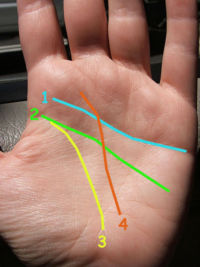
Palm reading is a terrific ESL exercise.
It’s familiar to almost all of our students and offers practice of the grammar of future forms, conditionals and modals, all at once. The predictions are highly personalized, something to which students respond well, and the exercises can be integrated, with speaking, listening, reading and writing all combining into a seamless activity. Even those who dismiss palm reading, tarot and the other methods of predicting our futures seem to enjoy the process of creating a potential future for one of their classmates; imagination and creativity are brought in, and the students invariably learn something about each other, and perhaps about themselves.

Apply These Creative Palm Reading Ideas to Your Teaching
-
1
A Good Starting Point: Vocabulary Brainstorm
Every culture in the world has some method of divining the future. Brainstorm these and compare them. What equipment is needed (cards, tea leaves, a crystal ball your palm)? Who might make the predictions (Romany women, soothsayers, fortune tellers, mystics)? What kind of predictions are normally made – are they about marriage, or work, or longevity?
-
2
A Quick Debate
To immediately begin using these words, hold a five-minute debate in pairs or small groups. Can such predictions be trusted? Do any of your students (or more likely, in my classes, their parents or grandparents) read horoscopes? Does anyone have experience of them coming true? If none of these classic methods are seen to be genuine, are there any other ways in which a person’s future might be foretold?
-
3
Learn the System
It makes a lot of sense, for the purposes of your class, to greatly simplify the process of palm reading. I’ve boiled it down to using only the left hand, and only four lines:
- The heart line
- The head line
- The life line
- The fate line (not everyone has one of these)
Have your students identify these lines on the left hand of their partner. It’s much more fun and interactive, as well as presenting a better practice opportunity, if your students are thinking not about themselves, and their own futures, but those of their neighbor.
-
4
Vocabulary for Reading the Lines
 The language of shapes will become important; your students will need to be able to describe the exact shape and form of the lines. Elicit these with simple board drawings:
The language of shapes will become important; your students will need to be able to describe the exact shape and form of the lines. Elicit these with simple board drawings:Curve, slope, swoop; circle, straight, wavy; broken, deep, shallow; separated, parallel
-
5
Reading the Heart Line
Ask your students to study the heart line and, either as a listening exercise or on a handout, provide these interpretative aids.
- Begins below the index finger – they are content with their love life
- Begins below the middle finger – they are selfish when it comes to love
- Begins in the center of the palm – they fall in love easily.
- Straight and short – they are less interest in romance
- Touches the life line – their heart is broken easily
- Long and curvy - they freely express emotions and feelings
- Straight and parallel to the head line – they have a good handle on their emotions
- Wavy – they will have many serious relationships
- Circle on the line – this indicates sadness or depression
- Broken line – this indicates emotional trauma
Now, the students should consider what this information may mean for their partner’s future. If they fall in love easily, does this mean they’ll make the wrong romantic choices? If they are in control of their emotions, does this imply they’ll avoid angry arguments? Invite them to begin building of a ‘picture’ of this person’s future.
-
6
Reading the Head Line
Next comes the head line, with these hints.
- Short line – they prefer physical achievements over mental ones
- Curved, sloping line – this indicates creativity
- Separated from life line – this indicates adventure and an enthusiasm for life.
- Wavy line – this implies a short attention span
- Deep, long line – this means their thinking is clear and focused
- Straight line – this means they think realistically
- Multiple crosses through head line – this tells of a sequence of important decisions
Again, they should make predictions based on this new data. Does an adventuresome spirit mean a lot of foreign travel, or an enthusiasm for extreme sports? Does a short attention span imply a lack of academic achievement? Build these findings into the ‘picture’ and add detail to their predictions for the future.
-
7
Reading the Life Line
These hints will help.
- Runs close to thumb – they will often become tired
- Curvy – they will have plenty of energy
- Long and deep – this indicates vitality.
- Short and shallow – they may be manipulated by others
- Swoops around in a semicircle – this means strength and enthusiasm.
- Straight and close to the edge of the palm – this means they are cautious in love
- Multiple life lines – this indicates extra vitality
- Circle in the line – this warns of hospitalization or injury
- Break in the line – this indicates a sudden change in lifestyle
Add this data to what we can already predict. Does the hospitalization connect with their adventuresome lifestyle? If they’re both cautious in love, and realistic, will they wait a long while before choosing a partner?
-
8
Reading the Fate Line
In my experience, only around 5-10% of students have one of these. If they do, here are the hints:
- Deep line – this indicates they are strongly controlled by fate
- Breaks and changes of direction – this indicates many changes in life due to external forces
- Starts joined to life line – this connotes a self-made individual who may be ambitious
- Starts at base of thumb and crosses life line – this tells of support offered by family and friends
-
9
Predicting the Future
Your students now have all the information they need to make a detailed prediction for their partner’s future. When might they marry, and with whom? What can we predict about work, family and travel? I’ve generally told the students that none of these lines can tell us how long we will live; this avoids the macabre prospect of warning a teenager that they may die in their thirties! Invite the students to indulge in as much detail as possible, using plenty of modal verbs (e.g. they might climb Mt. Everest; they could be an entrepreneur or a stockbroker) and conditional forms (e.g. ‘If they keep control of their emotions, they will be successful in business’).
-
q
Getting Reactions
These predictions are likely to cause quite a stir. How does the student react? Are any of these predictions particularly likely, or unlikely, to come true? Do they correspond to the student’s expectations for their own future? Can any of them be taken seriously?
This is a really fun exercise, with lots of practice opportunities for important grammar points.
It presents the chance for the class to unite around a common aim, to share elements of their own culture, and to use plenty of useful language.
P.S. If you enjoyed this article, please help spread it by clicking one of those sharing buttons below. And if you are interested in more, you should follow our Facebook page where we share more about creative, non-boring ways to teach English.







